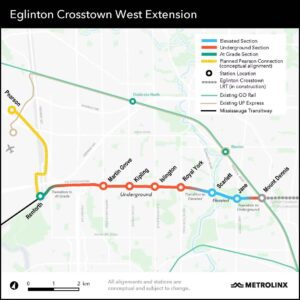The Eglinton Crosstown West Extension Tunnel

Location: Toronto, Ontario, Canada
Project Consortium Team: West End Connectors
Owner: Metrolinx
Operator: Toronto Transit Commission (TTC)
The Eglinton Crosstown West Extension Tunnel is the first phase of work for the extension of the Eglinton Crosstown Light Rail Transit (LRT) through Toronto and into Mississauga. The advance tunnel project will involve approximately 6km of tunnelling work.
The extension of the Eglinton Crosstown LRT (future TTC Line 5) will run 9.2 kilometres from the new Mount Dennis LRT station to Renforth Drive and will operate mainly underground.
 Following the completion of the project, new connections will be established to various transit networks in the region, including Union-Pearson (UP) Express and Kitchener Line GO train services at Mount Dennis, MiWay and GO bus services through the Mississauga Transitway at Renforth Drive, and TTC bus services at transit stations in Toronto.
Following the completion of the project, new connections will be established to various transit networks in the region, including Union-Pearson (UP) Express and Kitchener Line GO train services at Mount Dennis, MiWay and GO bus services through the Mississauga Transitway at Renforth Drive, and TTC bus services at transit stations in Toronto.
Metrolinx is the provincial agency overseeing the massive transit project, which when completed by 2030-31 will create a continuous rapid transit line that stretches from Scarborough, through midtown Toronto, and into Mississauga. The future TTC Line 5 will be owned by the Government of Ontario’s transport agency Metrolinx and operated by the Toronto Transit Commission (TTC), the public transit agency of the city of Toronto.
HGC was part of the consortium known as “West End Connectors” that was awarded the contract to design, build and finance the tunnels for the Eglinton Crosstown West Extension project.
In general, HGC’s work includes the selection of representative noise and vibration assessment and measurement locations, initial baseline noise and vibration measurements and monitoring in advance of construction; the prediction of noise and vibration caused by the proposed construction activities including tunneling; as well as ongoing measurements and monitoring of construction noise and vibration during construction.
Identification of Noise and Vibration Sensitive Receptors
Prior to construction, HGC reviewed imaging of the work zones, and conducted a tour of the surrounding area. Nearby residences, buildings likely to be located in the vibration Zone of Influence, and non-residential buildings such as commercial, industrial, or institutional buildings which may be sensitive to noise and vibration were identified.
Prediction and Assessment of Construction Noise and Vibration
An acoustical model of the construction activities was prepared based on the collected information, on digital mapping of the area surrounding the works, and on electronic drawings for the project.
Noise and Vibration Management

HGC was also responsible for the development of a Noise and Vibration Management Plan. The Plan identifies and documents the processes, required analyses, measurements, monitoring, and other supporting efforts necessary to ensure that the construction work is in compliance with the applicable construction noise and vibration requirements. The Plan enumerates the proposed major construction activities, identifies and describes prediction, assessment, and evaluation methods for ground-borne noise, air-borne noise, and vibration caused by the construction, and well as procedures for verifying that the works are being carried out is in compliance with the limits. A plan to mitigate and monitor noise and vibration is also included along with mitigation measures to be applied when and where the noise and vibration exceeds the applicable criteria are to be developed and discussed.
Noise and Vibration Measurements and Monitoring
HGC is undertaking a comprehensive noise and vibration measurement and monitoring program, involving noise monitoring stations at representative residential locations, vibration monitoring stations in buildings and at heritage structures, and attended measurements at key moments. HGC continues to consult with the project team on measures relevant to the complaints protocol, or on measures that could be considered to reduce or otherwise mitigate noise and vibration.
Acoustical Consulting Service Being Delivered:
- Identification of Noise and Vibration Sensitive Receptors
- Prediction and Assessment of Noise and Vibration during Construction
- Noise and Vibration Management Plan
- Ongoing noise and vibration monitoring

